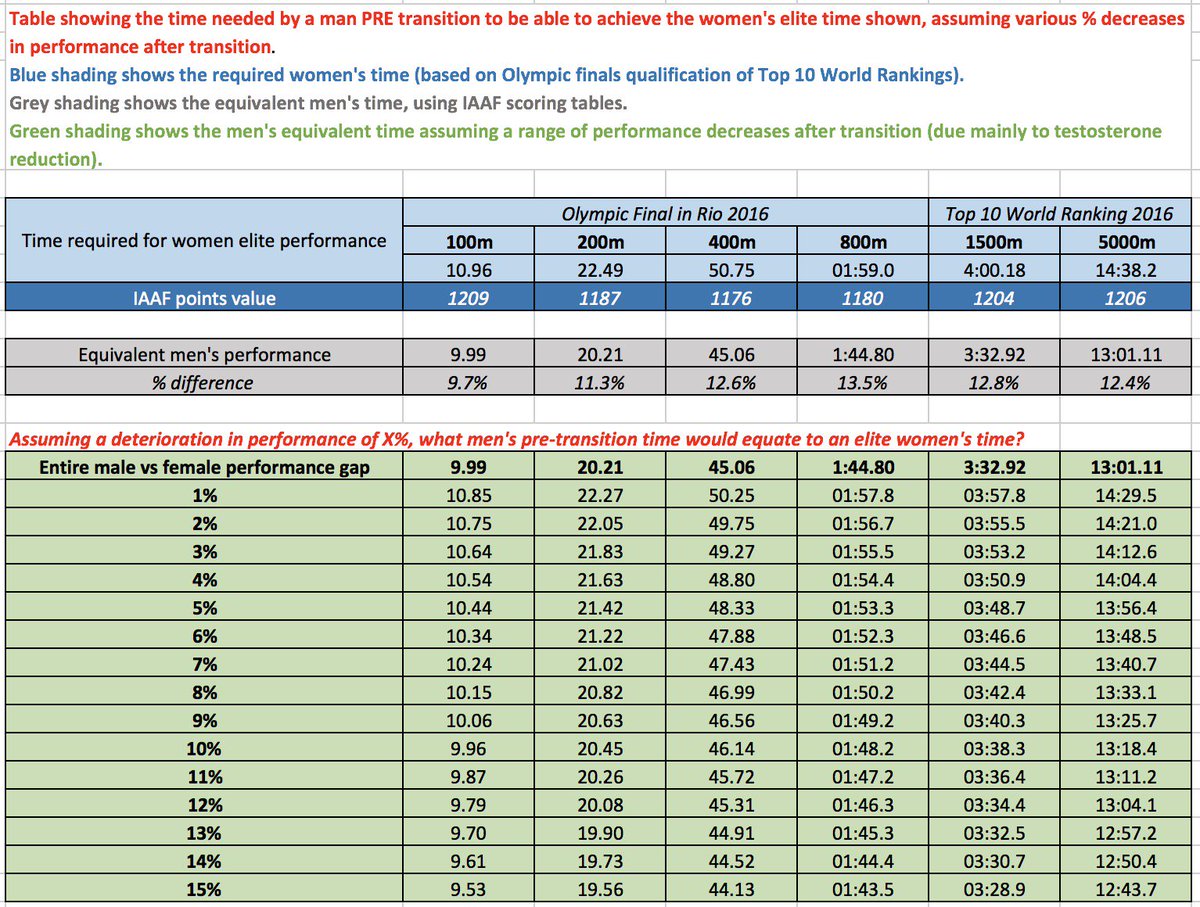
I've been thinking more about the transgender debate, so here's another thread. The performance issue/controversy really boils down to whether a transgender female (male to female transition, MTF) has an unfair advantage compared to women by virtue of "pre-transition advantage"?
If I could distill the question further, it would be: Does a transgender female perform RELATIVELY better as a female after transition than as a man before it? That is, if a person was at level X as a man, will they be at X as a woman, or X PLUS (better), or X MINUS (worse)?
Now, I can't stress enough - we don't *KNOW* the magnitude of performance change after transition. But, the policy in place for most sports compels transgender females to lower their testosterone levels (surgery or meds), and this does have some negative effect on performance.
So we are not in "men switching over and competing as women" territory, as some people seem to fear. However, we also can't just assume zero advantage. Ideally, one must try to quantify the magnitude of any transition induced change. Let me illustrate the point with data
In track & field, there are scoring tables for performance. This allows comparison between performances. For instance, a women's 100m time of 10.96s is the equivalent of a men's time of 9.99s. Over 400m, a woman's 400m of 50.75s is the same as a 45.06s for men.
These tables are useful to illustrate a conceptual point. Ideally, if transition from male to female happens without any advantage, the new (female) performance will be exactly equal to the old (male) performance. A transgender female would slot in exactly where they were before
If a transgender female "lost" all their advantage (this is one theory, bear with me), their performance as a woman would exactly equal their men's performance. On the other hand, if they lost only some of any advantage, then they would be relatively better in women's sport.
Correction (my bad). Here's a table showing men's equivalent performances PRIOR TO TRANSITION to achieve elite female times. I hope the concept makes sense. Basically, it asks how good male athletes need to be to transition to an elite female, given a certain % performance loss? 

For example: If the performance loss is 10% (the typical "male-female gap", & premise for lowering T levels for transgender females), then a man who could run 9.96s for 100m or 46.14s for 400m would be able to make an Olympic final after transitioning, as a woman. 

On the other hand, if the performance loss is only 5%, then it opens opportunity for "slower males" - a 10.44s 100m, a 48.33s 400m man, or a 1:53.3 800m, for example - would now run the times needed to make the Olympic final, as shown by the red shading 

I think there are 2 key things from this hypothetical exercise. First, nobody knows the size of performance changes after transition, but can you see why it matters? It's the difference between there being a problem, and there being none. If it's 10% or more, the issue is small 

But if it's a smaller decline, say 5%, it means that thousands of decent-but-not-great-men might be capable of running elite women's times. I think that the facts (such as they are), suggest a larger performance drop, around 10%, but that's only because the policy lowers the T
The other interesting thing is what it means for women's "performance equivalence". Let's go back to that 5% performance loss hypothetical example. This would allow a man who ran 10.44s for 100m or 48.33 400m as a man to make an Olympic final as a woman (see red in table) 

Now we can ask "What is the women's equivalent of a 10.44s 100m and 48.33s 400?". The answers are:
10.44s for men is equivalent of 11.66s for women, and 48.33s equates to 56.46s for the women. See the problem? Small % losses severely distort the "elite athletic requirement"
10.44s for men is equivalent of 11.66s for women, and 48.33s equates to 56.46s for the women. See the problem? Small % losses severely distort the "elite athletic requirement"
This is why it's so crucial to understand the performance loss if T is suppressed. If it's too small, then the equivalent of "mediocre" female athletes will start to win women's events. That's the biological reality. Whatever policy exists has to ensure a fair decrement.
My own personal feeling is that for the events I've described here, the current policy is not that far off. At a T level below 5nmol/L (it's currently 10), I think it gets better. The "crisis" is not as bad as people think, because I think the drop is > 10%
But I don't *KNOW* this with any data, that's only my first impression. I also don't know how one quantifies the performance changes in sports where stature, bulk, skeleton etc are crucial, because those don't go away. It's super tricky, but emotion doesn't advance anyone's cause
Anyway, that's today's thread. I promise, I will write a long article or two on this, and really try to expand thoughts. I just need a lot of time, because you can see how intricate teh arguments are, and how complex it is. But I'll get there. Until next time...
• • •
Missing some Tweet in this thread? You can try to
force a refresh





